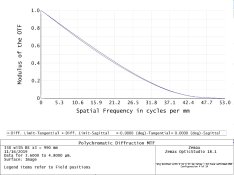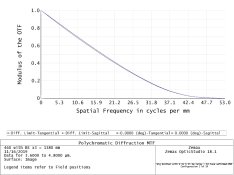To see Objective measurement data vs. Subjective guesses about resolution at different f/stop and FL.
Do you similarly question the value of MTF ratings published by lens manufacturers like Rodenstock?...what methods did they use, that makes their test more fundamentally believable?!
I think you should go re-read my statement in post 26 a bit more carefully, consider that your responses don’t align well with my original statement, and then leave it at that.
As an example, the following are what MTF plots I can share of a 50x zoom lens that I designed in 2013 (the date in the plots are today's date when I dredged up the design and captured these plots, but I worked this design in the spring of '13). It required on-axis diffraction-limited performance across the entire range of focal lengths. This was the upper range of focal lengths for a two-objective system.. hence "big brother" in the title. The other half, "little brother", extended the focal length range to 138x -- overall the focal length ranged from 10mm to 1380mm at the same f/# -- with overlap at the lower focal lengths.
At 25mm focal length

At 330mm focal length

At 990mm focal length

At 1380mm focal length

Other examples cannot be shared, and I cannot and won't share further information on this design. It simply serves as a real-world example.
In any case, perhaps now you understand what I mean when I say I am speaking from experience, and that it is possible to achieve consistent performance across the entire range of a zoom design. I can say this because I've achieved it myself many times over my lens design career, of which you see one example here. The old myth that zoom lenses cannot be as good as a fixed lens are, in this day and age, just that: A Myth.
What you don't know is what the design team decided was "good enough" MTF performance across the range of focal lengths... you are making an assumption which may not be correct. If you see a performance variation across the range of your modern zoom lens, it's because there are other considerations (size, weight, cost, schedule) that came into play during the design of that lens. As a general statement about optical design: Rarely is optical performance pushed to the max at the sacrifice of all other considerations. I only see that in astronomical telescopes, where optical performance is the most important consideration.











